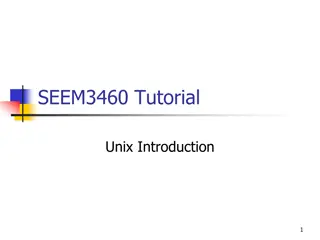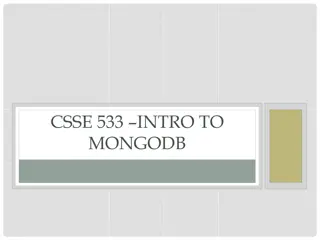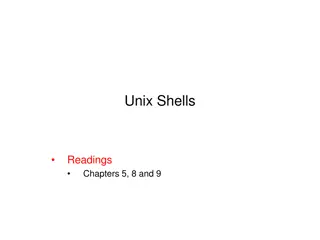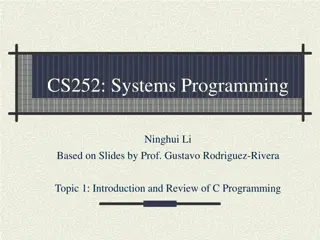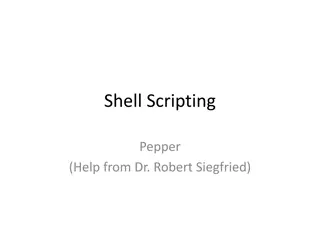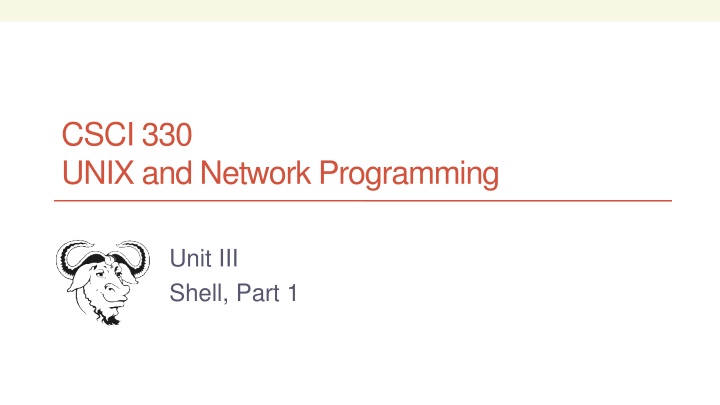
Understanding UNIX Shell Families and Basics
Explore the evolution and characteristics of various UNIX shell families, focusing on Bourne, C, and more. Learn about shell customization, variables, and their scope within the UNIX environment.
Download Presentation

Please find below an Image/Link to download the presentation.
The content on the website is provided AS IS for your information and personal use only. It may not be sold, licensed, or shared on other websites without obtaining consent from the author. If you encounter any issues during the download, it is possible that the publisher has removed the file from their server.
You are allowed to download the files provided on this website for personal or commercial use, subject to the condition that they are used lawfully. All files are the property of their respective owners.
The content on the website is provided AS IS for your information and personal use only. It may not be sold, licensed, or shared on other websites without obtaining consent from the author.
E N D
Presentation Transcript
CSCI 330 UNIX and Network Programming Unit III Shell, Part 1
CSCI 330 - UNIX and Network Programming 2 UNIX Command Interpreters common term: shell families: Bourne shell developed as part of original, commercial UNIX C shell developed as part of academic, free UNIX standard: every UNIX system has a Bourne shell compatible shell
CSCI 330 - UNIX and Network Programming 3 Bourne shell family sh: original Bourne shell written 1978 by Steve Bourne part of commercial UNIX ash: Almquist shell BSD-licensed replacement of sh bash: Bourne-again shell GNU replacement of sh dash: Debian Almquist shell small scripting shell
CSCI 330 - UNIX and Network Programming 4 bash shell basics Customization startup and initialization variables, prompt and aliases Command line behavior history sequence & substitution redirections and pipe
CSCI 330 - UNIX and Network Programming 5 Customization via command line options rarely done instead: process initialization file ~/.profile ~/.bashrc if login session shell if invoked from command line via variables terminal settings: speed, size, color path to find executables custom prompt command aliases
CSCI 330 - UNIX and Network Programming 6 Variables shell remembers values in variables variable has name and type: string, number, array to set string variable: Syntax: % varname=value to display variable s value % echo $varname
CSCI 330 - UNIX and Network Programming 7 Variables Examples: % speed=fast % echo Today we go $speed Today we go fast % speed="very fast" % echo Now we go $speed Now we go very fast
CSCI 330 - UNIX and Network Programming 8 Variable Scope valid for duration of shell invocation variable can be exported into environment: inherited by commands and subshells Example: % export fast
CSCI 330 - UNIX and Network Programming 9 some predefined variables Name Meaning HOME PATH USER SHELL PWD HOSTNAME HISTSIZE PS1 ? full pathname of your home directory list of directories to search for commands Your user name, also UID for user id full pathname of your login shell Current work directory current hostname of the system Number of commands to remember primary prompt (also PS2, ) Return status of most recently executed command $ Process id of current process
CSCI 330 - UNIX and Network Programming 10 Example: PATH variable PATH lists a set of directories shell finds commands in these directories on Linux: % echo $PATH /usr/sbin:/usr/bin:/sbin:/bin:/usr/games % PATH=$PATH:~/bin % echo $PATH /usr/sbin:/usr/bin:/sbin:/bin:/usr/games:/home/student/bin
CSCI 330 - UNIX and Network Programming 11 bash shell prompt can be set via PS1 shell variable Example: % PS1="$USER > " student > Secondary prompts: PS2, PS3, PS4
CSCI 330 - UNIX and Network Programming 12 bash shell prompt special PS1 shell variable settings: \w current work directory \h hostname \u username \! history event number \d date \t time \a ring the bell Example: % PS1="\u@\h-\!: " ege@turing-22:
CSCI 330 - UNIX and Network Programming 13 shell aliases Allows you to assign a different name to a command use alias like any other command to check current aliases: % alias to set alias: % alias ll="ls al" to remove alias: % unalias ll
CSCI 330 - UNIX and Network Programming 14 to create and keep aliases on the command line same scope as shell variables via a text file enter alias definitions into text file execute text file via source or . command reads and executes content of file in current shell make durable via the default startup files: ~/.profile or ~/.bashrc
CSCI 330 - UNIX and Network Programming 15 Command line behavior history sequence substitution i/o redirection and pipe
CSCI 330 - UNIX and Network Programming 16 Shell History record of previously entered commands can be: re-called, edited, re-executed commands are saved per session HISTSIZE=500 per user HISTFILESIZE=100 size of history can be set via shell variables
CSCI 330 - UNIX and Network Programming 17 Shell History Each command in history has a sequential event number to view the history buffer: Syntax: history [-c] [count] If no options are supplied, list all Useful options: -c clear history
CSCI 330 - UNIX and Network Programming 18 Command line editing UP ARROW move back one command in history list DOWN ARROW move forward one command LEFT and RIGHT ARROW move into command BACKSPACE and DELETE remove information TAB complete current command or file name
CSCI 330 - UNIX and Network Programming 19 Command Sequence allows series of commands all at once commands are separated by a semicolon ; Example: % date; pwd; ls
CSCI 330 - UNIX and Network Programming 20 Command Substitution command surrounded by back quotes ` is replaced by its standard output newlines in the output are replaced by spaces Examples: % echo `date` % ls -l `which passwd` % var=`whoami`; echo $var
CSCI 330 - UNIX and Network Programming 21 Command Substitution second form of command substitution: $(command) Examples: % echo User $(whoami) is on $(hostname) User ege is on turing % echo Today is $(date) Today is Fri Jul 17 08:06:28 CDT 2012
CSCI 330 - UNIX and Network Programming 22 Output Redirection (>) Syntax: command > file sends command output to file, instead of terminal Examples: % ls > listing % cat listing > filecopy Note: if file exists, it is overwritten
CSCI 330 - UNIX and Network Programming 23 Input Redirection (<) Syntax: command < file command reads (takes input) from file, instead of keyboard Example: % tr [a-z] [A-Z] < listing
CSCI 330 - UNIX and Network Programming 24 Examples: Output / Input Redirecting input and output: % tr [A-Z] [a-z] < r.in > r.out Output of command becomes input to next: % ls > temp.txt; wc < temp.txt Eliminate the middleman: pipe % ls | wc
CSCI 330 - UNIX and Network Programming 25 Appending Output Syntax: command >> file adds output of command at the end of file If file does not exist, shell creates it Examples: % date > usage-status % ls -l >> usage-status % du -s >> usage-status Build the file usage-status from the output of date , ls , and du
CSCI 330 - UNIX and Network Programming 26 Here Document read input for current source, uses << symbol Syntax: command << LABEL reads following lines until line starting with LABEL Example: % wc -l << DONE > line one > line two > DONE 2
CSCI 330 - UNIX and Network Programming 27 File Descriptor positive integer for every open file process tracks its open files with this number 0 standard input 1 standard output 2 standard error output bash can use file descriptor to refer to a file
CSCI 330 - UNIX and Network Programming 28 Redirection syntax Output: > or 1> filename 2> filename Input: < or 0< Combining outputs: 2>&1 or &> or >& Example: % cat hugo > /tmp/one 2>&1 or: % cat hugo &> /tmp/one
CSCI 330 - UNIX and Network Programming 29 Summary: Redirections and Pipe Command Syntax Meaning command < file redirect input from file to command command > file redirect output from command to file command >> file redirect output of command and appends it to file command > file 2>&1 command &> file command1 | command2 add error output to standard output, redirect both into file take/pipe output of command1 as input to command2 take input from current source until LABEL line command << LABEL
CSCI 330 - UNIX and Network Programming 30 Summary features of the UNIX shell: customization prompt, alias command line behavior history sequence, substitution redirections and pipe





